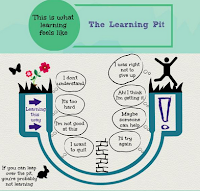Laura takes another look at what that might mean for us and for our students.
Enjoy!
From Laura Schultz...
Failure and Growth: A Recursive Connection
In my fifth grade classroom, we lightheartedly call
ourselves “The Best Failures” in the school!
These learners know that to be a “great failure” means
that with help, success is just around the corner. They
can articulate this to anyone who should warrant an explanation for such a
seemingly ludicrous comment because they consider themselves collaborative
learners and understand that the impetus for true learning is derived out of
mishaps, blunders, miscalculations and, well…failures.
One metaphor we use for this is “riding a backward bicycle.” Learning to ride a bike is a rite of passage
that occurs in steps and is much like the learning process itself. Beginning bike riders come to know that the
most intense learning is born from the bumps, bruises, and scrapes that occur
during the failure-to -launch stages. Deep understanding requires high impact
thinking on the part of the learner.
Backwards Brain
Bicycles and Metacognition
Last school year, Dr. Loane introduced us to a video from
the Smarter Every Day series that
highlighted the stages the vlog’s host and narrator, Destin Sandlin, went
through while relearning how to ride a bicycle that had been “tricked out” to
operate in an opposite fashion than what he had trained his brain to do from
the beginning as a bicycle rider.
 |
| This screenshot is from the YouTube video. What if it's not like riding a bike? |
This entertaining video emphasizes all of the stages
Destin experienced while relearning this process. Throughout, he graciously
accepts his failures as opportunities to be successful. The reflective nature of the video itself
highlights for the viewers the necessary application and transfer of skills
required to conquer his personal learning outcome.
When deciding to discover what my learners understood
about their own “thinking about thinking” reading
strategies, the bicycle video immediately came blasting into my brain. So, they
watched it. Needless to say they were
enthralled. They couldn’t wait to share
their own stories of failures and successes about learning how to ride a bike! The video and the subsequent enthusiasm for
failing turned out to be a great segue into the reading experiment that was
about to follow.
 |
| Watch the video at: Backward Bike |
Zones: Confidence,
Learning and Panic
Dr. Michael McDowell, the keynote speaker at a recent Indiana
Middle Level Education Association conference, likened learning to a
three-ringed target where each of the rings is a zone. The very middle of the
target is a confidence zone, the middle ring is the learning zone, and the
outermost ring in the panic or chaos zone.
 |
| Which zone are you in most of the time? |
Obviously, the confidence zone is the easiest place to live,
but living there is impossible without passing through all of the other zones,
often more than once. After many discussions about what type of learning
occurred in each of the zones for our backwards bicycle rider, my students
watched the video once more labeling the zone that Dustin was in and the
reasons why he fell into any one particular zone while on his journey to reach
his learning outcome.
I wondered aloud if the learners in front of me could
speak to the zone they were actually in during the reading process. Would they
panic? Would they fall off the metaphorical
bike? Or, would they confidently ride
off into the sunset?
Most took this as a challenge, and so our work began.
Data and Kidblog
Paired learners went to work listening to one another
read an article I purposefully assigned that was at their frustration levels.
The readers read while thinking aloud about the metacognition they were using
during the reading process itself. The
listeners used a tally mark system to count the number of times they heard the
reader comment about a learning strategy they consciously used to make
meaning.
Once they finished, they switched reader and listener
roles, and the data was returned to the appropriate reader and analyzed for
metacognition. The results drove a further discussion about what zones they
felt they were in regarding the use of reading strategies during this process.
What amazing comments ensued from the learners!
They spoke about being in a panic zone, falling off a
bike, and needing help. Students blogged their ideas as an assessment for all
to read. In this way, they learned from
many more of their peers, and not just from the one they were originally paired
with.
A few comments from the blogging site Kidblog have
been copied below. I’m hopeful that many
more comments and conversations cycle around our Humanities class regarding
problem solving when traveling from one zone to the next.
A Follow Up: The Learning Pit
I encourage everyone to visit James Nottingham’s (founder
of Challenging Learning)
website. There you will see a video that
likens learning to landing in a pit. The
premise is that learning involves being stuck in the pit, feeling confused, and
experiencing failures.
The only way to climb out of a pit is through challenge
and collaboration.
At HIJH, we seek to challenge, collaborate, and together
experience growth for all stakeholders in the learning process.
We hope your week is spent sometimes in the Comfort Zone, but often in the Learning Zone. If you get into the Panic Zone, check out the ideas on the right side of the Learning Pit!
Your HSE Teaching and Learning Team
- Jan Combs, Assistant Superintendent of Teaching and Learning
- Stephanie Loane, Director of Elementary Education
- Tom Bell, Director of Special Education
- Jeff Harrison, Director of Educational Technology
- Phil Lederach, Director of Secondary Education





No comments:
Post a Comment